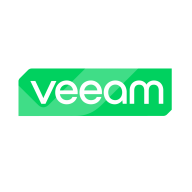

Elastic Observability and Veeam Data Platform both operate in the robust field of data solutions, focusing on observability and data protection, respectively. While Elastic Observability offers cost-effective versatility, Veeam Data Platform prevails in terms of data management performance due to its advanced features.
Features: Elastic Observability provides an end-to-end platform including machine learning features, centralized logging, and open-source flexibility appealing to budget-conscious users. Veeam Data Platform highlights instant VM recovery, replication capabilities, and streamlined backup and restore processes as its key strengths, enhancing its data protection solutions.
Room for Improvement: Elastic Observability requires better predictive analytics, infrastructure monitoring, and user-friendly automation, alongside expanded synthetic monitoring and customizable metrics visualization. Veeam Data Platform could enhance its support for physical server backups, improve cloud integration, and simplify its licensing model to address complexity.
Ease of Deployment and Customer Service: Elastic Observability offers deployment flexibility across cloud and hybrid infrastructures, bolstered by community-driven support and comprehensive documentation. Veeam Data Platform is more on-premises focused, offering robust direct customer support, praised for its straightforward setup process, whereas Elastic benefits mainly from community assistance.
Pricing and ROI: Elastic Observability is considered cost-effective for open-source users and offers reasonable pricing advantageous for large deployments, though potentially less so for smaller implementations. Veeam Data Platform, albeit more expensive, provides substantial ROI thanks to its feature-rich offerings that lead to reduced backup times and bolstered data protection, reflecting its commitment to quality features and support.
Elastic Observability seems to have a good scale-out capability.
What is not scalable for us is not on Elastic's side.
Integration with other vendors is also seamless.
In order to scale Veeam Data Platform, we have to pay a lot more money.
It is very stable, and I would rate it ten out of ten based on my interaction with it.
Elastic Observability is really stable.
There are no issues with stability in Veeam Data Platform.
It lacked some capabilities when handling on-prem devices, like network observability, package flow analysis, and device performance data on the infrastructure side.
One example is the inability to monitor very old databases with the newest version.
Elastic Observability could improve asset discovery as the current requirement to push the agent is not ideal.
Reducing it by 20% would make it more accessible to a broader range of customers.
The improvement we would like to see is the option to scale Veeam Data up in smaller sections rather than large sections, which requires paying much more.
The license is reasonably priced, however, the VMs where we host the solution are extremely expensive, making the overall cost in the public cloud high.
Elastic Observability is cost-efficient and provides all features in the enterprise license without asset-based licensing.
A reduction of 20% in the current cost would make the solution more attractive to clients.
From what I know, it is expensive to add modules, with a scale rating of eight out of ten.
the most valued feature of Elastic is its log analytics capabilities.
The most valuable feature is the integrated platform that allows customers to start from observability and expand into other areas like security, EDR solutions, etc.
All the features that we use, such as monitoring, dashboarding, reporting, the possibility of alerting, and the way we index the data, are important.
The platform is user-friendly, comprehensive, and compatible with numerous market solutions, including virtualization and bare metal servers.
It is also one of the most scalable backup solutions I've worked with.


Elastic Observability is primarily used for monitoring login events, application performance, and infrastructure, supporting significant data volumes through features like log aggregation, centralized logging, and system metric analysis.
Elastic Observability employs Elastic APM for performance and latency analysis, significantly aiding business KPIs and technical stability. It is popular among users for system and server monitoring, capacity planning, cyber security, and managing data pipelines. With the integration of Kibana, it offers robust visualization, reporting, and incident response capabilities through rapid log searches while supporting machine learning and hybrid cloud environments.
What are Elastic Observability's key features?Companies in technology, finance, healthcare, and other industries implement Elastic Observability for tailored monitoring solutions. They find its integration with existing systems useful for maintaining operation efficiency and security, particularly valuing the visualization capabilities through Kibana to monitor KPIs and improve incident response times.
Veeam Data Platform ensures comprehensive data resilience by offering secure backups and intelligent data insights, catering to the complexities of modern data management.
Veeam Data Platform empowers businesses with reliable data protection, orchestrated recovery, and streamlined management. Providing peace of mind, it guarantees data is secure, available, and effortlessly recoverable. Organizations benefit from features such as instant recovery, simplified management, and compatibility with virtual environments. While it shines in backup and restore capabilities, it calls for improvements in integration with physical servers and enhanced cyber security features.
What are the key features of Veeam Data Platform?Organizations in industries like finance, healthcare, and manufacturing utilize Veeam Data Platform for critical data management, ensuring business continuity and disaster recovery. Employed in securing both virtual and physical workloads, Veeam integrates cloud storage for enhanced scalability and efficiency.
We monitor all Cloud Monitoring Software reviews to prevent fraudulent reviews and keep review quality high. We do not post reviews by company employees or direct competitors. We validate each review for authenticity via cross-reference with LinkedIn, and personal follow-up with the reviewer when necessary.